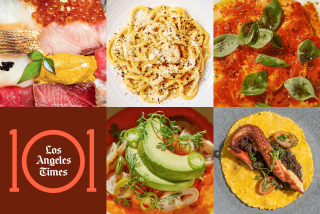Spain bottles sunlight
The other night at Bar Pintxo in Santa Monica there was a wine dinner of sorts. Which is to say a number of tables were pushed together to form a single surface, and a dozen strangers gathered to share heaping plates of cured salame and Idiazabal cheese, razor clams drenched in lemon and parsley, braised lamb and spicy chorizo stew. By the end of the evening strangers were friends, and a chilly spring evening seemed much warmer.
I couldn’t help thinking how different a meal like this was from one in a French restaurant: no tablecloths, no gleaming silver, no froufrou service. The first two courses were eaten more or less with fingers and toothpicks, and used napkins were dispensed onto the floor, as is done in Bilbao or Barcelona, Spain. One may question the politesse of such acts, but no one could question the meal’s lack of airs.
And into our tumblers was poured a Spanish white that seemed to herald spring as few wines could, the Do Ferreiro “Cepas Vellas” Albarino, from 200-year-old vines in Rias Baixas, Galicia, Spain. The wine was a glorious mess of contradictions: as profound as Grand Cru Burgundy yet immediately accessible like a house pour; bracing and complex, lashed with minerals and lees, and yet it seemed as warm and welcoming as fresh-baked bread.
In the end the wine, like the meal, was all about ease and comfort, about greeting warmer days with something fresh and inviting in your glass, as so many Spanish whites do.
Spain’s well-earned reputation for toothsome red wines has obscured somewhat the extraordinary leaps in quality that its white wines have made for the better part of two decades. Styles have generally shifted from inward and fusty to bright and racy, pristine wines from indigenous varieties possessing a warm, open-armed immediacy, perfect for spring meals.
Rias Baixas and Ribeiro
The white wine renaissance began in Galicia, a part of “Green Spain,” the coastal areas that escape the punishing heat and desert-like conditions of the inner plains and valleys. In Galicia, that means the wine regions of Rias Baixas and Ribeiro, which have ignited worldwide interest in Albarino, as well as other indigenous varieties such as Treixadura, Godello and Loueira.
Rias Baixas hugs the coastal areas from the Mino River north to the rugged, granite-inflected soils of O Salnes and O Rosal, which are fully exposed to ocean blasts. While there is some experimentation in the region with oak aging and richer, more malolactic-driven styles, the best wines are the most unadorned, from entry-level Albarinos such as Martin Codax and Burgans, to the more minerally, complex wines from the Do Ferreiro stable. Sadly, “Cepas Vellas” is always scarce in the market, but Do Ferreiro’s regular Albarino is more readily available, as is a lively, citrusy blend, “Rebisaca.”
Travel upriver along the Mino River and you’ll pass through Ribeiro, a tiny, breathtakingly vertiginous appellation that is perhaps Spain’s most resurgent for white wines. The region is less reliant on Albarino than Rias Baixas, using Treixadura and Godello more often, providing a broader, fleshier framework for the wines with pronounced leesy, biscuity overtones -- something Treixadura seems to accentuate -- to adorn rich pear and citrus notes.
The majestic blends of Emilio Rojo are perhaps the pinnacle of the region -- and at Burgundy prices, you’ll pay dearly for it. But more affordable Ribeiro can be found from Vina Mein, into which seven indigenous varieties are blended, or the citrusy blend of Treixadura and Torrontes from Bodegas do Campo.
Txakoli
North of Rias Baixas, coastal Spain makes a dogleg east in the direction of the continent, along the northern coast that forms the Biscay Bay. In the Basque hills above Bilbao and San Sebastian, the ocean influence is effectively cradled by the western thrust of the Pyrenees, forming another green belt, the regions gathered under the name Txakoli.
It is hard to imagine a friskier white wine category than the Txakolis of Basque Spain, as represented by two denominations of origin, Bizkaiko Txakolina and Getariako Txakolina. Nearly all of the whites are made with the indigenous Hondaribi Zuri, a brisk, herbaceous variety that captures a host of “green” scents: lime, parsley, scallion, lemon thyme, green apple.
If the Galician whites are a brisk caress, Txakoli whites are a relative slap in the face. The wines are bottled young to capture primary green-fruited flavors of lime zest, melon and star fruit; the textures are dry, minerally and bracing, usually including a mouthwatering prickle of effervescence, which gives them the thirst-quenching power of a lager.
Txakoli is a marvelous wine for shellfish, and its low alcohol makes it well suited to gulping down on a hot afternoon as well. Three brands are prevalent in the market: The Txakoli Getariakos from Ameztoi and Txomin Etxaniz, and the bracing Bizkaiko Txakolina from Gurrutxaga should be mandatory for every spring picnic basket.
Rueda
Triangulate southward from Galicia and Txakoli and you’ll run into Rueda, an anomalous stretch of white wine country along the Duero River roughly west of Ribera del Duero, and next to Toro, the hot new wine region for luscious reds.
Rueda lies well inland from the coast, where its relatively warm climate would seem inhospitable to white grapes. And indeed, for centuries the region was known for its sherry-like fortified wines, made in a toffee-ed, oxidative style, compelling in its way, but a long way from being spring-like in flavor. But in the ‘80s new anti-oxidative winemaking methods began to be employed, revealing a new lemony fresh style bursting with energy and character.
Charming whites are made here from two durable varieties, Verdejo and Viura. The flavors in your average Rueda white are generally richer than those of the coast: more Meyer lemon than lime, more melon and pear; even notes of tangerine and orange creep into the flavor spectrum; but they share a fine minerality with their coastal counterparts, and add a mildly bitter almond grip of the fruit tannins.
One of the more fetching -- especially considering the price of about $10 -- is an orange-scented blend of Verdejo and Viura called El Hada. Or seek out the interesting selection of 100% Verdejos in the market, such as the grassy Martinsancho, or the focused melon tinge in the old-vine Verdejo from Bodegas Shaya.
The Canary Islands
There is a Spanish region so far off the beaten path that it’s a stretch to think of it as Spain at all -- but even if it lies off the coast of west Africa, the Canary Islands archipelago is part of the Spanish Republic. A trickle of these unusual wines is entering the market here and worth seeking out, no matter what the season.
The Canary Islands’ dramatic volcanic formations support flora and fauna that might rival the Galapagos in wonder and stark weirdness. And its viticulture, like the vineyards on the island Lanzarote, is some of the most visually stunning on Earth. Planted in deep black sand, the vines are protected from the wind by stone walls built between vine rows; in some cases, vignerons build a semicircular cairn for each vine, where natural forces create a virtual crater for each wind-bitten vine, a moonscape unlike any other vine region in the world.
And the wines? In such a warm climate, the whites, made from the heat-resistant Malvasia and the indigenous Diego, are deeply colored, mineral and exotic. Perhaps it’s a stretch to think of these as spring wines, but they’re simply too interesting not to mention.
The Malvasia Seco from La Bermejos on the island of Lanzarote gives off a lovely citrus oil scent to complement rich fig and pear skin flavors, and a carbonic red from the same producer may be more spring-y, a Beaujolais-like beauty made from Listan Negra that brims with bright red fruit blossoms, from pomegranate to wild plum, a versatile pour with spring lamb, or to slake any warm spring gathering.
--
(BEGIN TEXT OF INFOBOX)
Where to buy Spanish whites
The 2008 Burgans Rias Baixas Albarino is available at the Wine House in West Los Angeles, (310) 479-3731, www.winehouse.com; Woodland Hills Wine Co. in Woodland Hills, (818) 222-1111, www.whwc.com; and Manhattan Fine Wines in Manhattan Beach, (310) 374-3454, about $13.
The 2008 Martin Codax Rias Baixas Albarino is available at Du Vin Wine & Spirits, West Hollywood, (310) 855-1161, www.du-vin.net; John & Pete’s Fine Wines & Spirits in West Hollywood, (310) 657-3080, www.johnandpetes.com; and Mel & Rose Wine & Spirits in West Hollywood, (323) 655-5557, www.melandrose.com, about $16.
The 2007 Do Ferreiro Rias Baixas “Cepas Vellas” is available at the Wine House, for about $22. Do Ferreiro’s other bottling, “Rebisaca,” is available at Wine Exchange in Orange, (714) 974-1454, www.winex.com; Manhattan Fine Wines, Manhattan Beach, (310) 374-3454,
www.manhattanfinewines.com; and Wine Country in Signal Hill, (562) 597-8303, www.thewinecountry.com, about $22.
The 2008 Vina Mein Ribeiro white blend is available at Wine Country in Signal Hill, about $15.
The 2008 Ameztoi Txakoli Getariakos is available at the Wine House; Wine Exchange in Orange; and Woodland Hills Wine Co., about $18.
The 2008 El Hada Rueda white blend is available at K&L; Wine Merchants, Hollywood, (323) 464-9463, www.klwines.com, about $10.
The 2007 Angel Rodriguez Martinsancho Rueda Verdejo is available at K&L; Wine Merchants, Hollywood; Colorado Wine Co. in Eagle Rock, (323) 478-1985; and Wine Country, Signal Hill, about $18.
The 2008 Bodegas Shaya Rueda Verdejo “Old Vines” is available at Woodland Hills Wine Co.; Wine Exchange; John & Pete’s; and Wally’s Wine & Spirits in Los Angeles, (310) 475-0606, www.wally wine.com, about $15.
And the exotic La Bermejos wines from the Canary Islands, the 2008 Malvasia Seco, and the 2008 Tinto Carbonico, Listan Negra, are currently available at Wally’s Wine & Spirits, about $25.
More to Read
Eat your way across L.A.
Get our weekly Tasting Notes newsletter for reviews, news and more.
You may occasionally receive promotional content from the Los Angeles Times.






